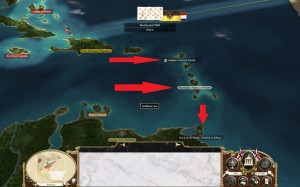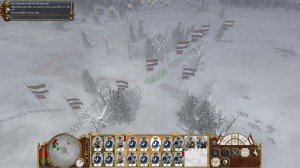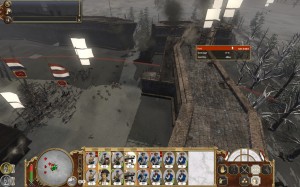If I had a penny for every game set in outer space, I’d be writing this post from somewhere sunnier and sandier. How many first-person shooters have cast us as Angry McShootsalot, the space marine? And how many RPGs and 4X games have treated us to “classic space opera” universes, the sort familiar to anyone who’s seen Star Trek or Star Wars, or read a Larry Niven novel? This extends to gameplay conventions. If you’ve played Master of Orion, Sword of the Stars, Galactic Civilizations, or Space Empires, you know the formula – players start with a single world at the dawn of the age of interstellar travel, then colonise virgin territory until eventually the whole galaxy is claimed. Technology progresses in a smooth upward line. The real fighting is all done in space; ground combat is abstracted to ‘bring troop transports and roll the dice’. Everything is clean and crisp and futuristic.
If I had a penny for every game set in an original version of outer space… well, at least I’d have one cent, courtesy of Emperor of the Fading Suns (EFS), the 1996 turn-based strategy game from Holistic Design, Inc (HDI). Set in the same universe as Fading Suns, HDI’s pen-and-paper RPG, EFS falls into the broad 4X genre defined by classics such as Civilization and the games I listed above, but carved out a space all its own. In EFS, the main conflict was human against human, though there was an alien menace in the background. And there was nothing crisp or clean or futuristic about its universe, filled with princes, priests, psionics and peasants in what’s usually described as “a cross between Dune and Warhammer 40,000”.
The princes were the players, competing to become emperor of the 40 “known worlds” that were all that was left of a once-thriving interstellar society. 40 worlds might not sound like a lot… but unlike other 4X games, where a world would be defined by a few numbers, in EFS each had its own unique, Civilization-sized hex grid map. Each had its own layout of continents, islands, oceans. Each had its own assortment of resources: fertile farmlands, oil-rich deserts and seas, mountain ranges containing ore and gemstones. They had different terrain palettes, and a very different feel – you would not mistake snowy Delphi, capital of the Atreides-knockoff House Hawkwood, for the jungle world Severus, capital of the Harkonnen-knockoff House Decados.
EFS’ combat system also emphasised the planetary level. Ground and space battles were fought Civ-style (without tactical combat) between stacks of up to 20 units at a time, with different units excelling at different phases of battle – for example, artillery could shoot first and target any unit, but would be vulnerable in “direct” or “close” combat. While there were relatively few types of space unit, the game’s lavish technology tree offered ground units aplenty, starting with basic tanks and self-propelled guns, and culminating in power-armoured assault legions, genetically engineered warbeasts, and hover tanks. Capital spacecraft (cruisers and dreadnoughts) could bombard enemy stacks before you sent in the ground troops, but they couldn’t hit every unit, and planet-to-space batteries – perhaps protected by the planetary shield! – could shoot back. Thus, to invade a world, gaining space superiority wasn’t enough – you had to land troops to establish a beachhead and fight your way across the surface, all the while keeping up a flow of new ground units from your homeworlds. As a result, EFS, better than any other game I’ve played, captures just how colossal an undertaking a planetary invasion would be.
EFS’ uniqueness extended to its victory conditions. To start with, players could trade favours to win control of what was left of the Imperial ministries (space fleets, spies, border garrisons) – every 10 turns, the players would elect one of their number to be the regent, the one in charge of handing out these offices. To win the game, you had to first be voted regent, then declare yourself emperor. Instead of putting you through the tedium of steamrolling every other claimant to the throne, EFS “just” required you to be confirmed by a final vote after another 10 turns.
And this was when the game was at its most exciting. To vote for regent or emperor, you needed two things. First, each player’s voting rights were represented by five sceptres – actual units on the map – and these could be stolen from one another (or from certain NPC factions). More sceptres, more votes. Second, you needed a noble in the capital to cast your vote. You started with five nobles – four on your homeworld, one in the capital – and if they all died, it was game over. Now, for most of the game, the capital was a neutral zone where assassins could strike, but overt conflict was forbidden. But once the regent crossed the Rubicon, that prohibition was lifted. Rival armies would converge on the capital to slaughter each other’s nobles while safeguarding their own. Battle fleets would take up position to stop the armies arriving. Blood would run in the streets, as neglected garrisons were overrun by their more prepared rivals. And hanging over your head was the looming deadline of that second vote. That was how a race for the imperial throne should feel. And that was how a strategy endgame should play.
To cap things off, EFS was also highly moddable: it had a map editor and it stored rules and unit data in Notepad-editable files. If you thought the common artillery unit was too powerful, or that special forces legions should be able to live off the land, you could change it yourself. But this was just the tip of the iceberg. Ambitious mods upped the challenge, reshaped the game’s economy, changed the combat rules, added whole new classes of units that could fight in space or on the ground.
Unfortunately, EFS also had its fair share of flaws. The game was quite clearly not a finished, let alone a polished, product. Vestigial, unimplemented features remain to tantalise the player – for example, you could throw your weight behind one Church sect or another, which had absolutely no effect but implies that the designers intended players to stack papal elections in their favour. And while the game did come with multiplayer, its AI barely knew how to play. Rather, my most challenging single-player experience came from a fan-made scenario that lumbered me with internal foes (a frail economy and a rebellious populace), in a prophetic flash-forward to 2005’s Rome: Barbarian Invasion.
For whatever reason, EFS did not succeed in the marketplace, and ultimately it made little impression on the genre. You will see plenty of Civilization or Master of Orion retrospectives and sequels, but none for EFS. Years later, the potential of the franchise glimmered again when HDI announced a spin-off project, Fading Suns: Noble Armada. Rather than being a 4X title, Noble Armada followed in the footsteps of “freelance starship commander” games such as Elite. Set during the peace following the emperor’s accession, it would have allowed players to venture into unknown space, trading, fighting, exploring and questing at the head of a small fleet. And Noble Armada made it quite far through the development process: I remember playing a pre-release demo, buggy and crash-prone but tantalisingly fun. But sadly, this flicker of hope never came to fruition. Noble Armada bounced from one publisher to another, before finally dying, never to see the light of day. With it died the Fading Suns franchise on the computer.
Nowadays, Emperor of the Fading Suns is a dusty entry on abandonware sites, and a fond memory in the minds of fans. It’s a sad fate for a game that, with a bit more polish and a better AI, would have been one of the best strategy games ever made. As it is, it’s still a gem, albeit a flawed one. It’s a unique experience, both in terms of game mechanics and flavour. And for a player looking for immersion rather than a competitive single-player experience, it still holds up very well. I wish it were both better known and more widely imitated. I can’t do anything about the latter, but with this post, I hope I can do something about the former.
Resources
Video tutorial (Nova mod)
Hyperion mod – my mod of choice when I played EFS
Nova mod – no personal experience with this but a lot of players like it
I hope you enjoyed this post! To quickly find this post, and my other feature articles, click the “features” tab at the top of this page.
Like this:
Like Loading...














